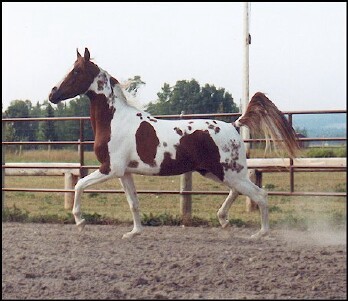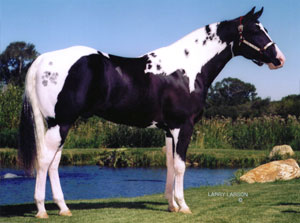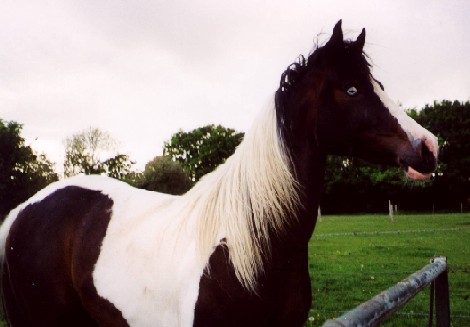tobiano horses





Tobiano horses have a dominantly inherited white spotting pattern and are one kind of paint. Tobiano (pronounced tow-be-yah-no) spotting is present in many breeds and types, including the Shetland and Australian Stock Horse, but absent from some predominant breeds, such as the Arabian and Thoroughbred. Some breed authorities do not allow the registration of paint horses of any sort.
Tobiano horses have a pattern of white hair with underlying pink skin. The tobiano pattern can occur with any coat color. It often occurs in combination with other patterns, for example in the tovero, which is a combination of tobiano and overo spotting. The pattern develops while the foal is still in the womb and remains throughout its life. Sometimes pigmented skin extends just beyond beyond a patch of color, into a white area. This makes it look as if there is a shadow or halo around the color patch, especially when the coat is wet. Horses with such halos are often called shadow paints, ghost paints, ribbons paints or halo paints. Tobiano horses may be either predominantly colored or white, or with a fairly even amount of white and color. They are identified by their white legs and solid colored head, whereas with other horses leg and face markings usually go together. Tobianos do not have extreme facial white, such as aprons or bald faces. White markings indicate a combination of patterns, or a different pattern, such as sabino, frame overo or splash.
On some tobiano horses there may be small colored spots, commonly called ink spots, paw prints or cat tracks, in the white patches. These are usually small and round and may occur in groups. This marking often occurs in horses homozygous for the tobiano gene, but isn’t a guarantee that the horse is homozygous. There may also be ermine spots or distal leg spots: spots of color in the white close to the hoof or above the ankle respectively. There may also be color around the chestnuts.
Tobiano horses are less common than some may think, most tobiano looking horses are a combination of tobiano and one of the other patterns. This is not surprising since breeders often cross paints together with regard to the phenotype (external appearance) rather than their genetic makeup. Tobiano can hide the characteristics of the other pattern genes, but extensive white face markings can give away a combinaion.
At the other end of the spectrum some tobiano horses do not have any body spots. These minimally marked horses are sometimes called "slipped tobiano". They have white leg markings and, in the absence of other pattern genes, a dark head, and are usually thought to be solid horses with white leg markings. They can, nevertheless, produce tobiano offspring as reliably as any other horse with the tobiano gene. It has been suggested that paint horses with extensive white are usually a combination of patterns, and this may well be the case. However the extent of white is probably also controlled by several (or perhaps many) other modifying genes. Such genes don’t directly cause a pattern to exist, but modify the expression of pattern genes when they do exist, so that different horses with the same pattern genes have more or less white according to which modifying genes are present. It doesn’t seem to be the case that horses homozygous for tobiano have more white than heterozygotes, since very minimal tobianos do occur that test homozygous for tobiano. Genotype testing for tobiano horses involves a combination of phenotype analysis, molecular genetics and pedigree analysis.
|
|









